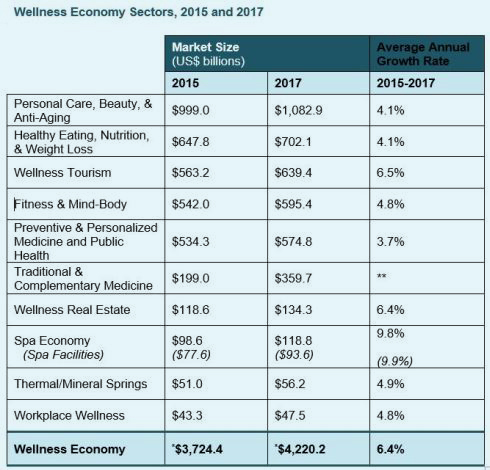The global wellness market grew nearly twice as fast as the global economy from 2015 to 2017 to reach US$4.2 trillion last year – and shows no signs of slowing down.
According to the 2018 Global Wellness Economy Monitor the global wellness market grew 12.8 percent (6.4 percent annually) from 2015 to 201 compared with the global economic growth rate of just 3.6 percent per annum.
Released by the non-profit Global Wellness Institute (GWI) at the 12th annual Global Wellness Summit in Italy, the Monitor provides “fresh evidence that wellness remains one of the world’s biggest and fast-growing industries”.
“Wellness expenditures ($4.2 trillion) are now more than half as large as total global health expenditures ($7.3 trillion)… and the wellness industry now represents 5.3 percent of global economic output,” the monitor reports.

GWI senior research fellow Katherine Johnston believes a “profound shift [in people’s attitudes to wellness] is driving powerful growth.”
“Once upon a time, our contact with wellness was occasional: we went to the gym or got a massage,” she said.
“But this is changing fast: a wellness mindset is starting to permeate the global consumer consciousness, affecting people’s daily decision-making – whether food purchases, a focus on mental wellness and reducing stress, incorporating movement into daily life, environmental consciousness, or their yearning for connection and happiness.
“Wellness, for more people, is evolving from rarely to daily, from episodic to essential, from a luxury to a dominant lifestyle value.”
According to the Monitor, the three strongest revenue growth sectors in the wellness market in 2015-2017 were the spa industry (9.8 growth per annum), wellness tourism (6.5 percent) and wellness real estate (6.4 percent).

The spa economy grew 19.8 percent from 2015 to 2017 to reach $118.8 billion with the number of spa locations jumping from 121,595 to over 149,000 (employing nearly 2.6 million workers) in the same period.
According to GWI, the 9.9 percent annual revenue growth for spas in 2015-2017 is much higher than the 2.3 percent recorded from 2013-2015.
GWI senior research fellow Ophelia Yeung added that “in the face of longer lifespans, and rising chronic disease, stress and unhappiness”, the Institute could “only see” further growth for the wellness market.
“But the wellness market isn’t just growing, it’s extremely dynamic,” she said.

